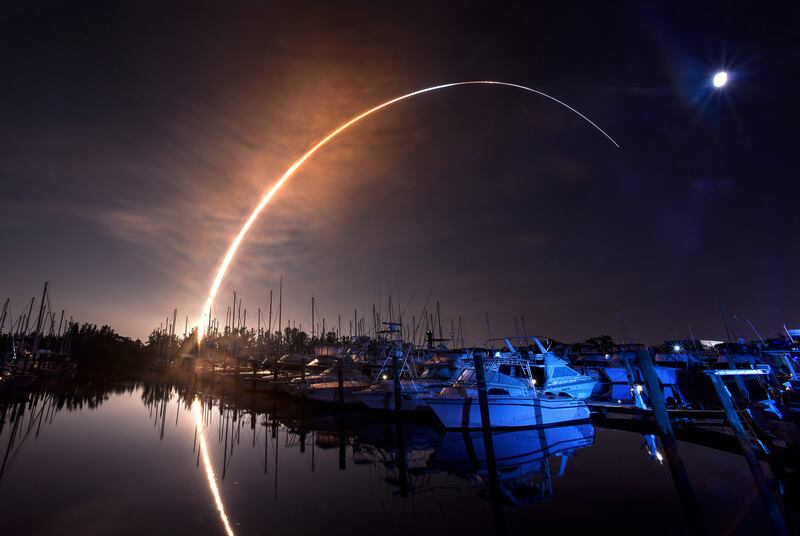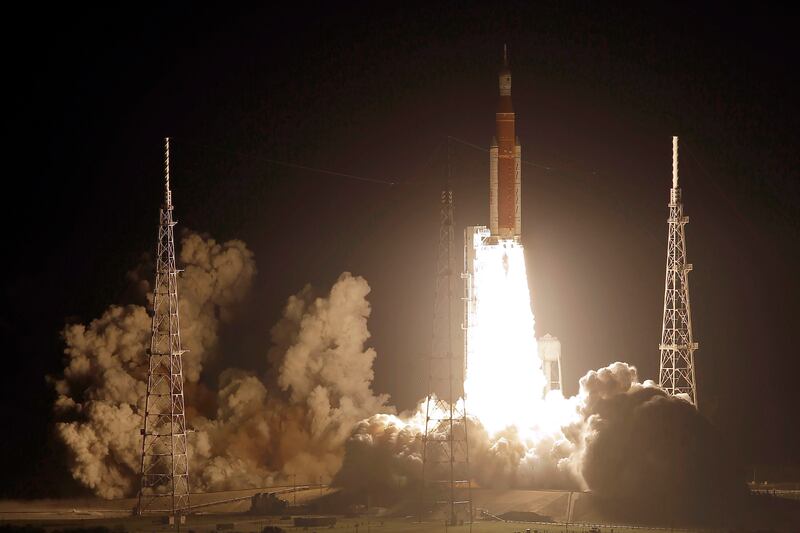Following months of delays that included two hurricane strikes and a pair of scrubbed launch attempts, NASA’s multiphase plan to put astronauts back on the moon, and eventually Mars, finally got off the ground early Wednesday as the Artemis I mission roared into space.
The world’s most powerful rocket, the Space Launch System, topped by the unmanned Orion crew capsule, lifted off from pad 39B at Cape Canaveral’s Kennedy Space Center at 1:47 a.m. Eastern time on Wednesday. The launch is the first leg of a mission in which Orion is planned to travel approximately 40,000 miles beyond the moon and return to Earth over the course of 25 days.
“What an incredible sight to see NASA’s Space Launch System rocket and Orion spacecraft launch together for the first time,” NASA Administrator Bill Nelson said in a statement. “This uncrewed flight test will push Orion to the limits in the rigors of deep space, helping us prepare for human exploration on the moon and, ultimately, Mars.”
NASA reports Orion deployed its solar arrays after reaching its initial orbit and engineers began performing checkouts of the spacecraft’s systems. About 1.5 hours into flight, the rocket’s upper stage engine successfully fired for approximately 18 minutes to give Orion the big push needed to send it out of Earth orbit and toward the moon.
Orion has separated from its upper stage and is on its outbound coast to the moon powered by its service module, which is the propulsive powerhouse provided by the European Space Agency through an international collaboration.
“It’s taken a lot to get here, but Orion is now on its way to the moon,” said Jim Free, NASA deputy associate administrator for the Exploration Systems Development Mission Directorate, in a statement. “This successful launch means NASA and our partners are on a path to explore farther in space than ever before for the benefit of humanity.”
Orion should reach the moon by Monday, more than 230,000 miles from Earth, according to The Associated Press. After coming within 80 miles of the moon, the capsule will enter a far-flung orbit stretching about 40,000 miles beyond. The Orion capsule is due back on Earth on Dec. 11 for a planned Pacific Ocean splashdown.

Two hurricanes have hit Florida’s Space Coast this fall
The SLS rocket/Orion space capsule stack was moved off its launch pad at Cape Canaveral’s Kennedy Space Center in late September as Hurricane Ian was roaring toward central Florida.
The 322-foot rocket found shelter in the nearby Vehicle Assembly Building for the weather and also allowed NASA to perform some needed maintenance to the rocket and spacecraft after two failed earlier launch attempts led to a long stay at launchpad 39B.
As late-season Hurricane Nicole approached Florida last week, NASA leaders decided the storm, much less ferocious than Ian, would not pose a significant threat to the SLS rocket package which rode out the weather on its pad.
NASA reported the rocket and capsule suffered some minor weather-related damage due to Hurricane Nicole’s high winds, but mission leaders deemed the issues were minor and began the countdown to Wednesday’s launch on Monday.
What happened with the first two Artemis I launch attempts?
The first launch attempt on Aug. 29 was shut down after a process to pre-cool the rocket engines in preparation for ignition failed to get one of the four engines to the required temperature of around minus 420 degrees Fahrenheit. In pre-launch preparations that day, NASA engineers also encountered a hydrogen leak that they eventually solved.
A second try on Sept. 3 also went awry, and was ultimately scrubbed, due to a leak in the liquid hydrogen fueling process that could not be solved in time to make the two-hour launch window that day.
NASA has since conducted a successful test of the SLS fueling process following repairs to several key fueling mechanisms and appeared ready for a third try in late September, before Hurricane Ian forced a rollback of SLS to indoor protection.
What is the Artemis mission?
The crewless Artemis I mission is scheduled to last just over 25 days on a flight that will allow NASA experts to test the new SLS components, many of which have been repurposed from the old space shuttle program and other systems, as well as the Orion space capsule.
That capsule, the eventual home for future space travelers, will be carried into lunar orbit where it will take a spin around the moon and then head back to earth for a fiery plunge through the atmosphere at some 25,000 mph before splashing down in the Pacific Ocean at the end of the mission.
Artemis I is just the first in a three-phase program aiming to put astronauts back on the surface of the moon for the first time since the final Apollo moon visit in December 1972.
Artemis II, currently anticipated for sometime in 2024, will head to space with a four-person crew in the Orion capsule that will fly the craft around the moon in further testing. Then, if all goes according to NASA’s current plan, the SLS/Orion package will return on a mission that will include a landing on the moon’s surface in 2025.
Along the way, NASA wants to put a small space station, the Lunar Gateway, in orbit around the moon and has future plans that include a moon base station, the Artemis Base Camp.

Why does NASA want to return to the moon?
In a posting on the Artemis missions’ website, NASA lists a few reasons why it’s devoting billions of dollars to making moon landings, once again, a priority.
“We’re going back to the moon for scientific discovery, economic benefits and inspiration for a new generation of explorers: the Artemis Generation,” NASA says. “While maintaining American leadership in exploration, we will build a global alliance and explore deep space for the benefit of all.”
While a return to the moon smacks a little of “been there, done that,” NASA says it’s committed to accomplishing some other first benchmarks as part of the series of Artemis missions, including extending manned exploration deeper into the solar system.
“With Artemis missions, NASA will land the first woman and first person of color on the moon, using innovative technologies to explore more of the lunar surface than ever before,” NASA says in a web posting. “We will collaborate with commercial and international partners and establish the first long-term presence on the moon. Then, we will use what we learn on and around the moon to take the next giant leap: sending the first astronauts to Mars.”
SLS rocket fun facts
NASA says its SLS launch system stands at 322 feet high — taller than the Statue of Liberty — and weighs 5.75 million pounds when loaded with fuel.
During launch and ascent, the SLS produces 8.8 million pounds of maximum thrust, 15% more thrust than the Saturn V rockets that propelled Apollo astronauts to the moon.


